Around the year 1242, a young man studying at the University of Naples met a bright and learned preacher named John of St. Julian. John belonged to a new religious order and lived with some brother friars in a house near the university. (This probably raised a few eyebrows, since at that time those in religious life typically lived in monasteries).
Other members of his order set up similar houses near the University of Paris and other universities around Europe. Each of these residences was known as a house of studies, and they were places of spiritual formation and educational support for students who would eventually become preachers.
John of St. Julian, the story goes, took this particular student under his wing and introduced him to the works of Aristotle and Maimonides and other philosophers, as well as the spirituality and works of his order, the Dominicans. The student flourished under John’s direction, and he joined the order himself. His experience at the Naples house of studies set off a long and exceptionally brilliant career in the academy and the church.
That student’s name? Tommaso d’Aquino — Thomas Aquinas.
The Dominican house of studies in Naples clearly hit a home run in the way it reached and nurtured Aquinas, but there were many like him who were attracted to the community, spirituality, and love of learning that they found in such settings. It’s no surprise that the house of studies model for education and formation enjoyed popularity among a variety of religious groups throughout the centuries. In fact, it’s still in use at many theological schools in North America — although John of St. Julian and Thomas Aquinas might be surprised at how it’s evolved over the years.
Today's houses of studies
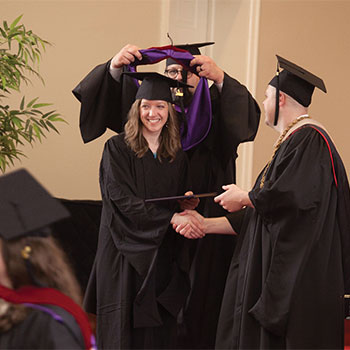 |
Mallorie Hansmann, a student at the Luther House of Study at Sioux Falls Seminary, receives her diploma from President Greg Henson during the seminary's 157th commencement in May 2015. Hansmann was one of four Luther House of Study graduates last year.
Image Credit: Carder Photography |
In the United States and Canada, the most common incarnation of the house of studies model has been denominationally affiliated study centers located on the campus of a school affiliated with a different denomination. For example, Duke Divinity School, a United Methodist institution in Durham, North Carolina, hosts three such denominational centers: the Anglican Episcopal House of Studies, the Baptist House of Studies, and the Presbyterian/Reformed House of Studies. According to Curtis Freeman, director of the Baptist house, Baptist faculty and staff serve as advisers and mentors for more than 100 students from various Baptist denominations, affiliations, and affinities. The house assists students with a variety of needs, including financial aid, field education, ministry placement, spiritual formation, and alumni networking. It offers a certificate of Baptist studies, which is designed to meet the academic and formation requirements of students preparing for ordained and lay ministry in the Baptist tradition.
In South Dakota, Sioux Falls Seminary, which is affiliated with the North American Baptist Conference, also has two such centers. The Luther House of Study serves Lutheran students at the seminary. The Wesley House of Study does the same for students from the United Methodist and Wesleyan faith traditions.
“Our houses of study arose out of need and mission, not as an enrollment or marketing tactic,” says Greg Henson, president of Sioux Falls Seminary. “This part of the country has a good number of Lutheran, Baptist, and United Methodist churches, which is one of the reasons students from those denominations have enrolled here.” Indeed, while distance learning makes theological education more accessible than ever, those students who want an in-person seminary experience but can’t (or don’t want to) move to a distant school affiliated with their own denomination are some of the most likely to benefit from a house of studies. But that’s not all that’s going on, Henson says. “We are beginning to see students from those denominations enroll in our seminary even though they might live farther away.”
These houses of study do a substantial amount of extracurricular work: They organize regular fellowship for current Lutheran and United Methodist students and local clergy, connect students with denominational representatives such as bishops and district superintendents, and serve as clearinghouses of information about credentialing requirements and ordination.
But they also handle some curricular responsibilities. At Sioux Falls Seminary, Luther House and Wesley House offer denominationally specific courses on polity, doctrine, missiology, and other topics. (There aren’t significant differences across denominational lines for most classes that M.Div. students take, such as pastoral care, biblical studies, and church history.)
House benefits
“To me one of the great selling points of coming to Duke as an Anglican is that students are getting their formation in an ecumenical context,” says David Marshall, director of Duke’s Anglican Episcopal House of Studies. “Hopefully students are going to serve in an ecumenical context; they’re going to serve in a church just down the road from a Catholic church, a Baptist church, a nondenominational church. So to come from a place where they have studied and made friends with people from all those traditions is a great — I would say almost indispensable — advantage.”
Of course, students belonging to the same tradition as the school also get the ecumenical exposure, so it can be seen as a win–win for students, no matter their affiliation.
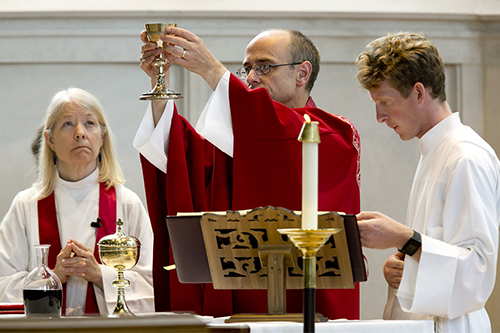 |
|
The Anglican Episcopal House of Studies (AEHS) at Duke Divinity School holds a celebration of Holy Eucharist in Goodson Chapel with the Rev. Dr. David Marshall, AEHS director, presiding, and the Rev. Liz Dowling-Sendor, associate director, assisting.
Image Credit: Duke Photography
|
While these houses of studies perform important functions for students, they also benefit the theological school in at least two important ways. First, no matter how or why they were established, they do increase the pool of potential students. “We are firmly Baptist and that will never change,” says Henson, the president of Sioux Falls Seminary. “At the same time, God is calling us to serve his wider kingdom by developing students [from other traditions]. Our houses of study enable us to prepare our students for the ministry to which God has called them, and they help us develop partnerships that extend beyond the walls of our school, our city, and even our denomination.”
Downsizing into a new house
For seminaries looking to expand, establishing a house of studies may be an appealing consideration. In addition, seminaries that are struggling to fulfill their mission may also find the house of studies model appealing: While there is a wide range of factors to consider, it’s possible to successfully “downsize” from a full-scale seminary to a house of studies at another institution.
The Swedenborg School of Religion did just that in 2001, when dwindling student numbers and steep annual deficits drove the board of the 130-year-old seminary to sell its campus near Boston, reorganize itself as a house of studies, and become affiliated with Pacific School of Religion (PSR), which is part of the Graduate Theological Union in Berkeley, California. (For more about that move and the early years after the transition, see the New Year 2004 issue of In Trust, online at www.intrust.org/Magazine/Issues/New-Year-2004/AfterWords. In Trust Center members can log in to read the whole article.)
“Originally, it was not seen as a slam dunk move,” says the Rev. James F. Lawrence, who shepherded the Swedenborgians’ move from the Boston area to Berkeley. “People on the East Coast were upset that the seminary that had been there for so long was leaving; there were doubts about whether this was a wise move or not. But over time — I think it’s fair to say that the journey has been considered a successful one. [Our denomination] is proud of what we’ve been able to accomplish.”
One of the positive outcomes of this arrangement has been the improved visibility of and public education about this small, distinctive denomination. “When we came, no one knew who Swedenborgians were,” Lawrence says. “After 15 years, hundreds of students at PSR and the GTU now know about us. They’ve met our students or taken our classes. We’ve proven ourselves as collegial, solid citizens in the neighborhood, and that’s a great positive.”
There were tradeoffs, though, that came with the shift from seminary to house of studies. “Our students were admitted to PSR, so we lost control over admissions,” Lawrence says. “We also lost control over the way the formation journey for clergy was shaped. While we had control over our own curriculum — seven classes — we lost control over curriculum [as a whole].”
Despite the challenges, Lawrence says, “We still felt overall that our students were getting a better education because they were training with the best and the brightest of other traditions, scholars who could teach specific subjects better than any of our faculty could. We just had to work extra hard to support the particularity of the Swedenborgian way of approaching spirituality, scripture, and theology.”
On July 1, 2015, after about two years of deliberation, the Swedenborgian House of Studies changed its name and affiliation once again, this time to the Center for Swedenborgian Studies at the Graduate Theological Union.
Lawrence says the decision for this recent change was inspired by a new understanding of the institution’s mission, which is to function as a global think tank for Swedenborgian studies and also as the official seminary of the Swedenborgian Church of North America. Affiliating with the GTU — a consortium of eight seminaries, including PSR, plus a dozen other religious and academic centers and affiliates — will allow the Center for Swedenborgian Studies to achieve both of these things more fully than if it had remained at PSR, says Lawrence.
But its time as a house of studies at PSR was a key reason the Center for Swedenborgian Studies was able to envision itself in this new way. “It allowed us to get out of the independent seminary model that had become unsustainable for us,” Lawrence says. “We were able to walk away from many costs, everything from HR to the copy machines. And over the past 15 years we were able to retool and rebuild our faculty resources.”
Lawrence says that the new Center for Swedenborgian Studies continues to have a close relationship with PSR, and he remains on the PSR faculty while serving as dean of the new center. “Our offices are still on their campus. We’ve changed the name of the sign on the door, but that’s it.”
This, of course, leads to the question of terminology. Is a house of studies the same thing as a center? When is it different?
What’s in a name?
One thing that’s changed since Aquinas’ days in Naples: These days, a house of studies is typically an office rather than an actual house. But beyond that, Lawrence says he believes the choice of a name is often a matter of semantics. “‘Center’ is the nomenclature that higher education seems to be using more frequently now. In many ways you could say the house of studies model would do the same things as a center. You could be a Wesleyan house of studies or you could be a Wesleyan center and you would do the same things.”
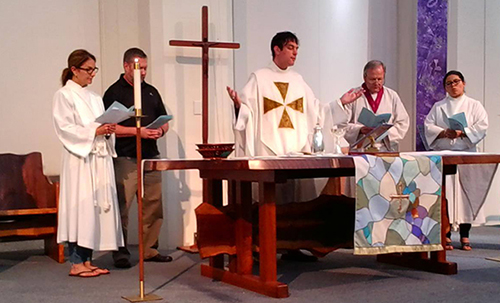 |
Rev. Nathan Biornstad, a graduate of Bloy House, The Episcopal Theological School at Claremont, presides at a Maundy Thursday service in Kresge Chapel at the Claremont School of Theology.
Image Credit: Bloy House |
On the other hand, just because the name “house” is part of the title doesn’t make it a traditional house of studies. Bloy House in Claremont, California, for instance, traces the “House” in its name back to Anglican High-Church terminology — the name of Nashotah House, an Episcopal seminary in Wisconsin, has the same genesis. Bloy House doesn’t consider itself a house of studies, but rather a theological school.
Founded by Los Angeles Bishop Francis E. Bloy in 1959 to serve commuting students seeking formation for lay, diaconal, and priestly ministries in the Episcopal Church, Bloy House operates as a weekend seminary on the campus of Claremont School of Theology, a United Methodist institution. In addition to Claremont, Bloy House has two other “sister seminaries”: Episcopal Divinity School in Cambridge, Massachusetts, and Church Divinity School of the Pacific in Berkeley, California. Since Bloy House is not accredited, students who pursue a master of divinity receive that degree from one of the sister seminaries. Bloy itself offers an Anglican Studies certificate and a diaconal certificate.
“Many of our students couldn’t do a degree at any of these schools without the program at Bloy House,” says the Rev. Sylvia Sweeney, the dean and president, indicating that many students have full-time jobs they want to keep and families that want to stay put.
Students at Saint Francis de Sales Seminary in St. Francis, Wisconsin, look a lot different than their colleagues at Bloy House: At Saint Francis, all students are single, and most are young, living together at the seminary as they pursue ordination in the Catholic Church.
Ten years ago, Saint Francis de Sales stopped offering classes to these students and instead enrolled them at the nearby Sacred Heart Seminary and School of Theology in Hales Corners, Wisconsin. Archbishop (now Cardinal) Timothy Dolan, who was Saint Francis’ board president at the time, floated the idea as a way to steward the resources of both seminaries. He consulted with the Saint Francis board of trustees and faculty, as well as the archdiocesan priests council, the pastoral council (a board of lay Catholics), and the college of consultors (a body that considers the more important acts of administration by the bishop).
Today, Saint Francis de Sales continues to operate as a seminary, but its students receive a master of divinity degree from Sacred Heart. “There are four pillars of priestly formation — pastoral, human, spiritual, and intellectual,” says the seminary rector, Father John D. Hemsing. “Basically, we handle the first three pillars here, and the intellectual pillar is handled at Sacred Heart.”
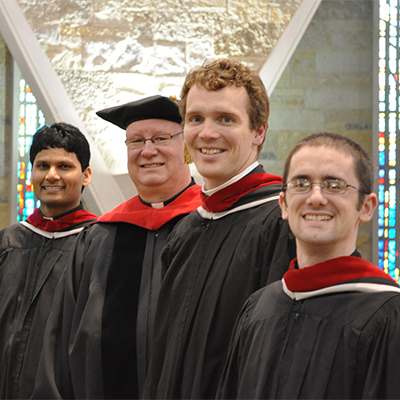 |
Saint Francis de Sales Seminary students receive a master of divinity degree from Sacred Heart Seminary and School of Theology. Pictured here are Saint Francis rector John Hemsing and Saint Francis students at the 2013 graduation ceremony in Sacred Heart Chapel. From left to right: Father Arul Ponnayan, Father John Hemsing, Father Philip Schumaker, and Father Patrick Burns.
Image credit: Jonathan Drayna |
Every weekday except Wednesday, Saint Francis’ seminarians carpool 15 miles to Sacred Heart, where they take their academic classes. Sacred Heart has a distinct mission to educate second-career seminarians, so the mix of students has provided some unexpected — mostly positive — dynamics. “They get to be with other seminarians who are a little more seasoned, who bring wisdom,” Hemsing says. “And our guys bring a youthful energy. It’s a nice exchange between the two.” Saint Francis de Sales reserves Wednesday as a community day, when its seminarians eat together, work in their teaching parishes, and focus on spiritual formation and worship.
A key aspect of all of these places — both those called houses of studies and those that aren’t — is their connection with another institution. Whether they are part of a larger, somewhat differently focused organization, or closely linked to a similarly focused external institution, these places can only fulfill their mission through sponsorship or relationship with other institutions.
For example, neither Saint Francis de Sales Seminary nor Bloy House are accredited by the Association of Theological Schools, so the partnerships they maintain are necessary for their students to receive their degrees from accredited institutions.
But the other key aspect of each of these places — and perhaps the more important one — is their focus on spiritual formation and faith-forming practices. At the houses of studies at Duke and Sioux Falls, at the Center for Swedenborgian Studies at GTU, at Bloy House and at St. Francis de Sales, formation is what makes them more than just denominational studies programs.
“I continue to be impressed by the discipline of students who participate in Morning Prayer, Eucharist services, listening groups, and the annual retreat,” says David Marshall of Duke’s Anglican Episcopal House. “It’s a major commitment to add the dimension of formation to their already full schedules.” But it’s a commitment rooted in a long tradition, and one that continues to bear fruit.
At our house, innovation is welcome
Like many old houses, the house of studies model has undergone renovation and expansion over time. While the initial purpose of these places was to provide formation within a particular denomination or religious order, some houses of studies have tweaked the original design to make it more applicable to contemporary ministry. Here are three examples of houses of studies doing especially innovative work.
A place to prioritize Latino ministry
Duke Divinity School’s Hispanic House of Studies was established in 2007 to support and strengthen ministries to and with Hispanic and Latino/a residents of North Carolina, where that population has grown from about 3,000 in 1990 to close to 900,000 today. “The Divinity School, The Duke Endowment, and the two United Methodist conferences in North Carolina recognized the significant need of the church to reach out to this growing population,” says Ismael A. Ruiz-Millán, director of Hispanic House. “Establishing this house of studies was one of the ways to address that need.”
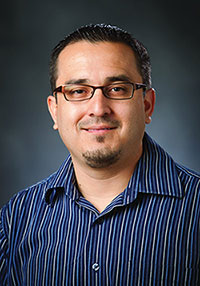 |
| Ismael Ruiz-Millán |
Since 2012, there’s been an average of 24 Latino students each year. While Ruiz-Millán can’t say for certain that Hispanic House has helped attract them to campus, he does share one illuminating fact: In 2006, when he was pursuing his M.Div. degree from Duke, the divinity school had just three Latino graduates.
Students involved with Hispanic House take part in Caminantes (“Walkers”), a group that meets weekly for spiritual formation with a Hispanic perspective. The house also leads a spiritual retreat in the fall, runs a preaching initiative and a Caminantes group for Latino and non-Latino pastors, and is a member of the Hispanic Summer Program, which offers courses on Hispanic history, theology, and ministry. They sponsor a Methodist “course of study” program in El Salvador, Guatemala, and Perú for people training for Methodist ministry, and they administer a scholarship program funded by The Duke Endowment, a North Carolina–based foundation that benefits United Methodist students pursuing a career in Hispanic ministry.
Hispanic House’s many offerings, combined with the challenge of defining and understanding Hispanic issues, keep the staff on its toes. For instance, Caminantes meetings are conducted in Spanish, so students need to speak the language in order participate. But some Latino students who want to be involved with Hispanic House programming don’t speak Spanish. Hispanic House started a forum this year as a venue to discuss these and similar challenges, as well as broader questions about Latino/a and Hispanic identity.
While some students perceive Hispanic House as a place only for Methodists, Ruiz-Millán says the house is open to all students who want to do Hispanic ministry, regardless of their denominational affiliation or whether they are themselves Latino. Nonetheless, part of Hispanic House’s mission is to serve as a resource center for the state’s two United Methodist judicatories. To that end, Hispanic House staff members expect that its alumni will become leaders for Hispanic ministry within North Carolina’s United Methodist community and beyond.
Finally, Hispanic House does one other important job, simply by virtue of its presence at the divinity school. “It’s a reminder to administrators that the Hispanic-Latino/a community needs to be on their minds as they strategize about the future of the school — and as they think about the future of the church,” Ruiz-Millán says.
A place to focus on urban ministry
By 2050, estimates have 70 percent of the world’s population living in major cities. Students and others connected with Newbigin House of Studies in San Francisco know that statistic by heart.
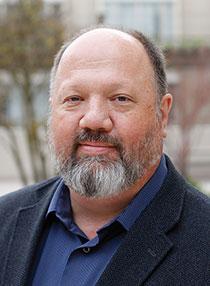 |
| Scot Sherman |
As a ministry of City Church San Francisco, a congregation of the Reformed Church in America, Newbigin House sponsors speaker series and other public events, discipleship training, and — through a partnership with Western Theological Seminary in Holland, Michigan — theological education. The Rev. Scot Sherman, executive director of Newbigin House, has called it a “virtual house” because of the distance-learning component. But the curriculum, which leads to either a master of divinity or a master of arts degree, also includes campus intensives at Western Seminary, ministry immersion experiences at resource teaching churches in San Francisco, a ministry internship in a major city, and a mentorship program. The focus throughout the program is urban church planting and revitalization.
“When I moved to New York City [after seminary] in 1989 I learned pretty quickly that there simply is no better place for ministry formation than cities, the centers of influence that shape the cultures we all live in,” writes Sherman on the Newbigin House website.
The house of studies is named after Lesslie Newbigin (1909–1998), a British theologian and missionary to India whose writings about church mission helped pave the way for the contemporary missional church movement. Insights from Newbigin have guided the development of the house’s academic programs. “We feel that much of the standard theological curriculum was in fact shaped in the context of Christendom,” Sherman says in an interview posted on the website of the Newbigin House of Studies. “To really develop people for effective ministry in a post-Christian environment, that curriculum itself needs to be rethought. What does a missional curriculum really look like?”
A place for common ground
But even houses of study that have a more traditional mission can be innovative. One such example is the Anglican Episcopal House of Studies (AEHS) at Duke Divinity School, which is first and foremost dedicated to nurturing and preparing Episcopalians and other Anglicans for service to the church. That description, however — “Episcopalians and other Anglicans” — hints at some of the challenges AEHS faces. The sometimes-rancorous rifts between Anglican groups in North America make it easy for the groups to give each other plenty of space. “On the whole they keep apart,” says David Marshall, director of AEHS. “But here at Duke we keep them together.”
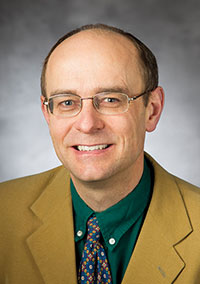 |
| David Marshall |
For instance, in 2014 AEHS hosted a series of conversations about the divisions among North American Anglicans over human sexuality, scriptural authority, interpretive practices, and church leadership. One outcome of those conversations was a book published last year, A House Divided? Ways Forward for North American Anglicans (Wipf & Stock). The Archbishop of Canterbury, Justin Welby, wrote the foreword, and other contributors include Duke Divinity School students and church leaders. According to the book itself, the goal of the project was to “expose seminary students to the profound and painful reality of ecclesial divisions in North American Anglicanism while cultivating skills for leading congregations to worship, pray, and serve in ways that contribute over time to the full, visible reconciliation of Episcopalians and other Anglicans in North America.”
Marshall recognizes one clear benefit that the Anglican Episcopal House enjoys as an entity of a Methodist-affiliated research university: “I’m simply under the authority of the dean of the divinity school,” he says. While AEHS cultivates relationships with bishops and other clergy from the Episcopal Church, the Anglican Church in North America, and other Anglican groups, it maintains a level of independence and a reputation as a place where people of different Anglican affiliations can come together for conversation and communion.
Dorsey McConnell, the Episcopal bishop of Pittsburgh, describes AEHS as a “happy anomaly,” and that’s a phrase that has stuck with Marshall. “I think it’s quite a nice way to describe what we do.”